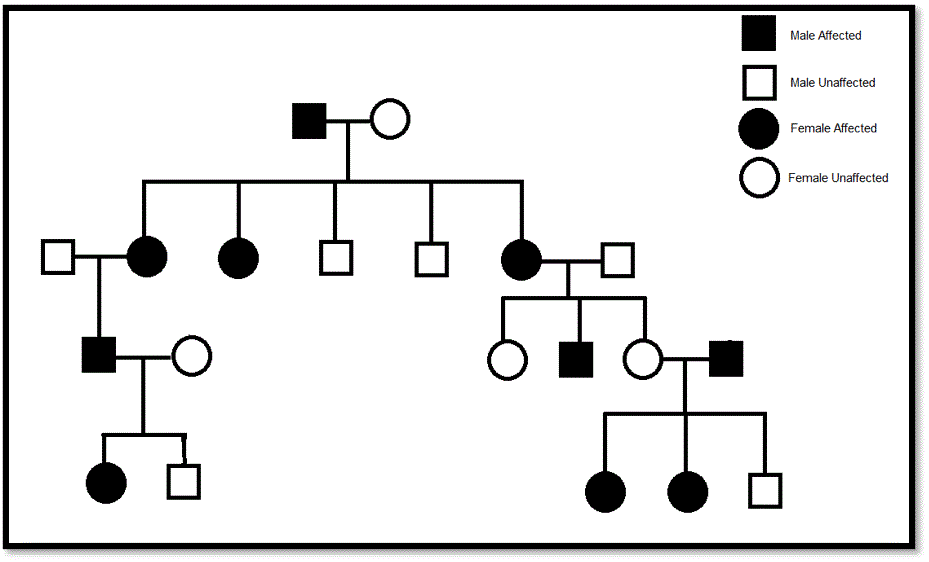WBR0390
Jump to navigation
Jump to search
| Author | [[PageAuthor::Yazan Daaboul, M.D. (Reviewed by Yazan Daaboul, M.D. and Alison Leibowitz [1])]] |
|---|---|
| Exam Type | ExamType::USMLE Step 1 |
| Main Category | MainCategory::Genetics |
| Sub Category | SubCategory::Endocrine |
| Prompt | [[Prompt::A 32-year-old man presents to the physician's office to inquire about a disease that is prevalent in his family. He is unsure what the disease is. Instead, he creates a family tree that demonstrates all the affected and unaffected family members. The patient’s family tree is shown below. What is the most likely disease in this patient’s family? |
| Answer A | AnswerA::Leber’s hereditary optic neuropathy |
| Answer A Explanation | [[AnswerAExp::Leber’s hereditary optic neuropathy is a mitochondrial disease, which is maternally inherited.]] |
| Answer B | AnswerB::Albinism |
| Answer B Explanation | [[AnswerBExp::Albinism has an autosomal recessive mode of inheritance.]] |
| Answer C | AnswerC::Hypophosphatemic rickets |
| Answer C Explanation | [[AnswerCExp::Hypophosphatemic rickets has an X-linked dominant mode of inheritance.]] |
| Answer D | AnswerD::Ocular albinism |
| Answer D Explanation | AnswerDExp::Ocular albinism has an X-linked recessive mode of inheritance. |
| Answer E | AnswerE::Schizophrenia |
| Answer E Explanation | AnswerEExp::Schizophrenia has a polygenic mode of inheritance. |
| Right Answer | RightAnswer::C |
| Explanation | [[Explanation::The pedigree demonstrates an X-linked dominant pattern of inheritance. X-linked dominant inheritance pattern is characterized by inheritance of disease from affected fathers to daughters and affected mothers to sons. Among the list of options, hypophosphatemic rickets (vitamin D-resistant rickets) is the only disease with X-linked dominant pattern of inheritance. Hypophosphatemic rickets is caused by a mutation in the PHEX gene and is characterized by increased phosphate wasting at the level of the renal proximal convoluted tubule. It is the most common cause of familial hypophosphatemia. The onset of manifestations is usually during childhood with a wide range of clinical features. Severe forms are associated with bone deformities (e.g. osteomalacia, knock knees, and bowed legs), abnormal growth, and dental abnormalities. Educational Objective: X-linked dominant inheritance pattern is characterized by inheritance of disease from affected fathers to daughters and affected mothers to sons. Hypophosphatemic rickets is an example of X-linked dominant inheritance pattern that causes phosphate wasting at the level of renal proximal tubule. |
| Approved | Approved::Yes |
| Keyword | WBRKeyword::X-linked, WBRKeyword::X-linked dominant, WBRKeyword::Pedigree, WBRKeyword::Inheritance, WBRKeyword::Hypophosphatemic rickets, WBRKeyword::Inheritance pattern |
| Linked Question | Linked:: |
| Order in Linked Questions | LinkedOrder:: |
